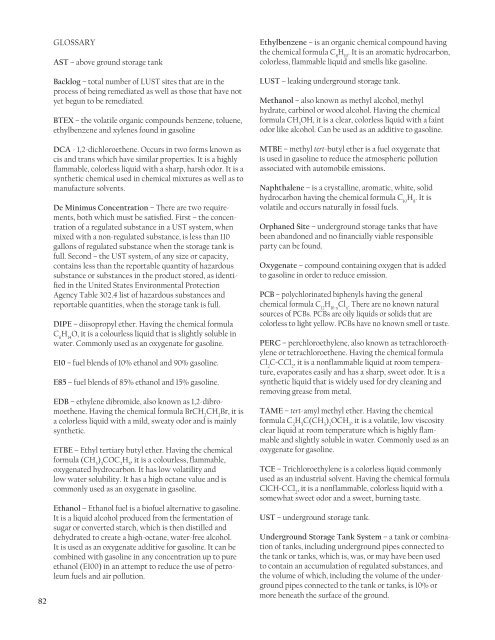Groundwater in the Great Lakes Basin
Groundwater in the Great Lakes Basin
Groundwater in the Great Lakes Basin
You also want an ePaper? Increase the reach of your titles
YUMPU automatically turns print PDFs into web optimized ePapers that Google loves.
82<br />
GLOSSARY<br />
AST – above ground storage tank<br />
Backlog – total number of LUST sites that are <strong>in</strong> <strong>the</strong><br />
process of be<strong>in</strong>g remediated as well as those that have not<br />
yet begun to be remediated.<br />
BTEX – <strong>the</strong> volatile organic compounds benzene, toluene,<br />
ethylbenzene and xylenes found <strong>in</strong> gasol<strong>in</strong>e<br />
DCA - 1,2-dichloroe<strong>the</strong>ne. Occurs <strong>in</strong> two forms known as<br />
cis and trans which have similar properties. It is a highly<br />
flammable, colorless liquid with a sharp, harsh odor. It is a<br />
syn<strong>the</strong>tic chemical used <strong>in</strong> chemical mixtures as well as to<br />
manufacture solvents.<br />
De M<strong>in</strong>imus Concentration – There are two requirements,<br />
both which must be satisfied. First – <strong>the</strong> concentration<br />
of a regulated substance <strong>in</strong> a UST system, when<br />
mixed with a non-regulated substance, is less than 110<br />
gallons of regulated substance when <strong>the</strong> storage tank is<br />
full. Second – <strong>the</strong> UST system, of any size or capacity,<br />
conta<strong>in</strong>s less than <strong>the</strong> reportable quantity of hazardous<br />
substance or substances <strong>in</strong> <strong>the</strong> product stored, as identified<br />
<strong>in</strong> <strong>the</strong> United States Environmental Protection<br />
Agency Table 302.4 list of hazardous substances and<br />
reportable quantities, when <strong>the</strong> storage tank is full.<br />
DIPE – diisopropyl e<strong>the</strong>r. Hav<strong>in</strong>g <strong>the</strong> chemical formula<br />
C 6<br />
H 14<br />
O, it is a colourless liquid that is slightly soluble <strong>in</strong><br />
water. Commonly used as an oxygenate for gasol<strong>in</strong>e.<br />
E10 – fuel blends of 10% ethanol and 90% gasol<strong>in</strong>e.<br />
E85 – fuel blends of 85% ethanol and 15% gasol<strong>in</strong>e.<br />
EDB – ethylene dibromide, also known as 1,2-dibromoe<strong>the</strong>ne.<br />
Hav<strong>in</strong>g <strong>the</strong> chemical formula BrCH 2<br />
CH 2<br />
Br, it is<br />
a colorless liquid with a mild, sweaty odor and is ma<strong>in</strong>ly<br />
syn<strong>the</strong>tic.<br />
ETBE – Ethyl tertiary butyl e<strong>the</strong>r. Hav<strong>in</strong>g <strong>the</strong> chemical<br />
formula (CH 3<br />
) 3<br />
COC 2<br />
H 5<br />
, it is a colourless, flammable,<br />
oxygenated hydrocarbon. It has low volatility and<br />
low water solubility. It has a high octane value and is<br />
commonly used as an oxygenate <strong>in</strong> gasol<strong>in</strong>e.<br />
Ethanol – Ethanol fuel is a biofuel alternative to gasol<strong>in</strong>e.<br />
It is a liquid alcohol produced from <strong>the</strong> fermentation of<br />
sugar or converted starch, which is <strong>the</strong>n distilled and<br />
dehydrated to create a high-octane, water-free alcohol.<br />
It is used as an oxygenate additive for gasol<strong>in</strong>e. It can be<br />
comb<strong>in</strong>ed with gasol<strong>in</strong>e <strong>in</strong> any concentration up to pure<br />
ethanol (E100) <strong>in</strong> an attempt to reduce <strong>the</strong> use of petroleum<br />
fuels and air pollution.<br />
Ethylbenzene – is an organic chemical compound hav<strong>in</strong>g<br />
<strong>the</strong> chemical formula C 8<br />
H 10<br />
. It is an aromatic hydrocarbon,<br />
colorless, flammable liquid and smells like gasol<strong>in</strong>e.<br />
LUST – leak<strong>in</strong>g underground storage tank.<br />
Methanol – also known as methyl alcohol, methyl<br />
hydrate, carb<strong>in</strong>ol or wood alcohol. Hav<strong>in</strong>g <strong>the</strong> chemical<br />
formula CH 3<br />
OH, it is a clear, colorless liquid with a fa<strong>in</strong>t<br />
odor like alcohol. Can be used as an additive to gasol<strong>in</strong>e.<br />
MTBE – methyl tert-butyl e<strong>the</strong>r is a fuel oxygenate that<br />
is used <strong>in</strong> gasol<strong>in</strong>e to reduce <strong>the</strong> atmospheric pollution<br />
associated with automobile emissions.<br />
Naphthalene – is a crystall<strong>in</strong>e, aromatic, white, solid<br />
hydrocarbon hav<strong>in</strong>g <strong>the</strong> chemical formula C 10<br />
H 8<br />
. It is<br />
volatile and occurs naturally <strong>in</strong> fossil fuels.<br />
Orphaned Site – underground storage tanks that have<br />
been abandoned and no f<strong>in</strong>ancially viable responsible<br />
party can be found.<br />
Oxygenate – compound conta<strong>in</strong><strong>in</strong>g oxygen that is added<br />
to gasol<strong>in</strong>e <strong>in</strong> order to reduce emission.<br />
PCB – polychlor<strong>in</strong>ated biphenyls hav<strong>in</strong>g <strong>the</strong> general<br />
chemical formula C 12<br />
H 10-x<br />
Cl x<br />
. There are no known natural<br />
sources of PCBs. PCBs are oily liquids or solids that are<br />
colorless to light yellow. PCBs have no known smell or taste.<br />
PERC – perchloroethylene, also known as tetrachloroethylene<br />
or tetrachloroe<strong>the</strong>ne. Hav<strong>in</strong>g <strong>the</strong> chemical formula<br />
Cl 2<br />
C=CCl 2<br />
, it is a nonflammable liquid at room temperature,<br />
evaporates easily and has a sharp, sweet odor. It is a<br />
syn<strong>the</strong>tic liquid that is widely used for dry clean<strong>in</strong>g and<br />
remov<strong>in</strong>g grease from metal.<br />
TAME – tert-amyl methyl e<strong>the</strong>r. Hav<strong>in</strong>g <strong>the</strong> chemical<br />
formula C 2<br />
H 5<br />
C(CH 3<br />
) 2<br />
OCH 3<br />
, it is a volatile, low viscosity<br />
clear liquid at room temperature which is highly flammable<br />
and slightly soluble <strong>in</strong> water. Commonly used as an<br />
oxygenate for gasol<strong>in</strong>e.<br />
TCE – Trichloroethylene is a colorless liquid commonly<br />
used as an <strong>in</strong>dustrial solvent. Hav<strong>in</strong>g <strong>the</strong> chemical formula<br />
ClCH=CCl 2<br />
, it is a nonflammable, colorless liquid with a<br />
somewhat sweet odor and a sweet, burn<strong>in</strong>g taste.<br />
UST – underground storage tank.<br />
Underground Storage Tank System – a tank or comb<strong>in</strong>ation<br />
of tanks, <strong>in</strong>clud<strong>in</strong>g underground pipes connected to<br />
<strong>the</strong> tank or tanks, which is, was, or may have been used<br />
to conta<strong>in</strong> an accumulation of regulated substances, and<br />
<strong>the</strong> volume of which, <strong>in</strong>clud<strong>in</strong>g <strong>the</strong> volume of <strong>the</strong> underground<br />
pipes connected to <strong>the</strong> tank or tanks, is 10% or<br />
more beneath <strong>the</strong> surface of <strong>the</strong> ground.

















